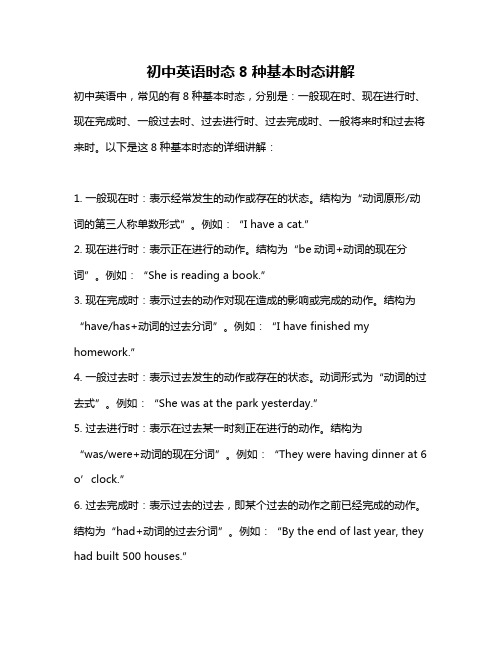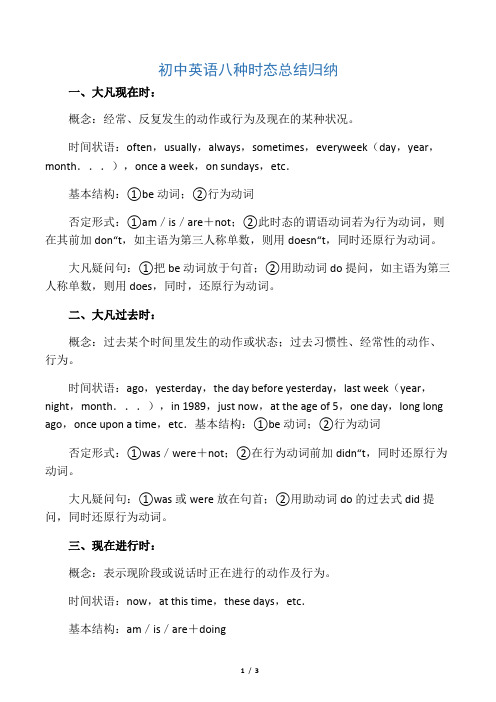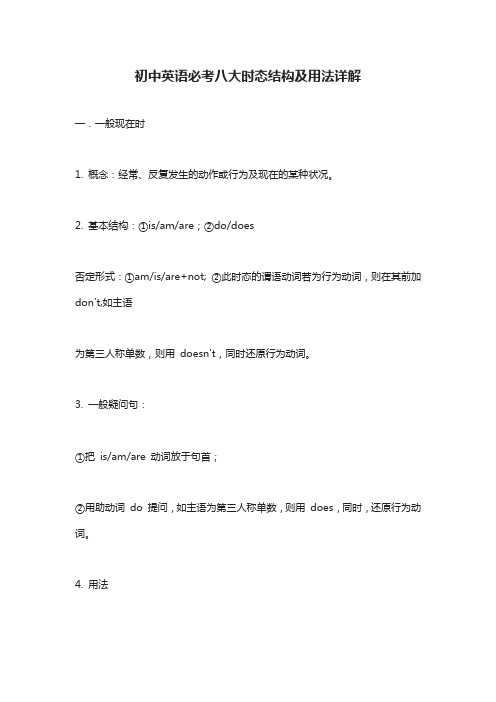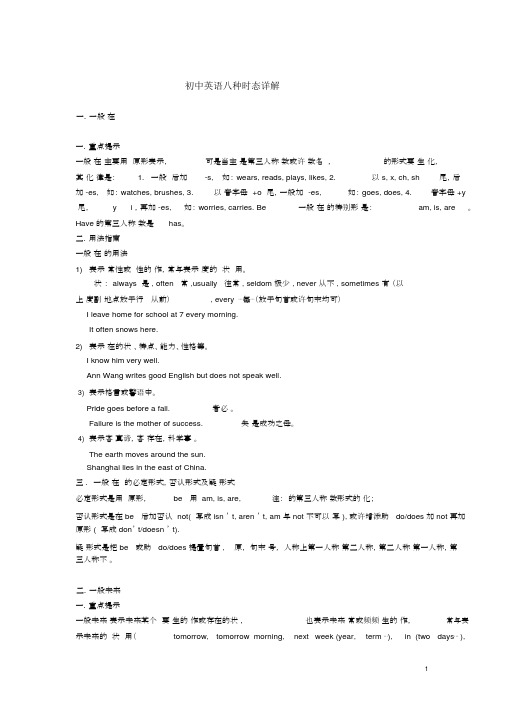初中英语八种时态归纳复习 详解
中考英语八种时态知识点归纳

中考英语八种时态知识点归纳如下:1. 一般现在时* 表示经常性或习惯性动作,常与表示频度的时间状语连用:I leave home for school at 7 every morning.* 表示现在的状态、特征、职业、能力、感觉等:He works as a driver.* 表示真理、客观存在、科学事实或用于格言警句中:Shanghai lies in the east of China.* 表示现在瞬间的动作:Here comes the bus!* 表示将来:表按规定、计划、安排将要发生的动作(仅限于某些表示“来、去、动、停、开始、结束、继续”等的趋向动词),可以与表示未来的时间状语搭配使用。
常见的用法是:飞机、火车、轮船、汽车等定期定点运行的交通状况。
如:The next train leaves at 3 o’clock this afternoon.2. 现在进行时* 表示现在正在进行的动作。
* 表示现阶段正在进行或从事的动作,但动作不一定正在进行。
3. 现在完成时* 表示动作发生在过去,但与现在有关系,强调对现在的影响。
* 表示从过去某一时刻开始一直延续到现在(可能还会继续延续下去)的动作或状态。
4. 现在完成进行时* 表示某一动作开始于过去某一时刻,一直延续到现在。
5. 一般过去时* 表示过去某个时间发生的动作或存在的状态。
* 表示过去经常或反复发生的动作。
6. 过去进行时* 表示在过去某一时刻或某一段时间正在进行的动作。
7. 过去完成时* 表示在过去某一时刻之前已经完成或结束的动作或状态。
8. 一般将来时* 表示将来某个时间要发生的动作或存在的状态。
* 表示将来经常或反复发生的动作。
以上就是中考英语中常见的八种时态,希望对你有所帮助。
初中英语时态8种基本时态讲解

初中英语时态8种基本时态讲解初中英语中,常见的有8种基本时态,分别是:一般现在时、现在进行时、现在完成时、一般过去时、过去进行时、过去完成时、一般将来时和过去将来时。
以下是这8种基本时态的详细讲解:1. 一般现在时:表示经常发生的动作或存在的状态。
结构为“动词原形/动词的第三人称单数形式”。
例如:“I have a cat.”2. 现在进行时:表示正在进行的动作。
结构为“be动词+动词的现在分词”。
例如:“She is reading a book.”3. 现在完成时:表示过去的动作对现在造成的影响或完成的动作。
结构为“have/has+动词的过去分词”。
例如:“I have finished my homework.”4. 一般过去时:表示过去发生的动作或存在的状态。
动词形式为“动词的过去式”。
例如:“She was at the park yesterday.”5. 过去进行时:表示在过去某一时刻正在进行的动作。
结构为“was/were+动词的现在分词”。
例如:“They were having dinner at 6 o’clock.”6. 过去完成时:表示过去的过去,即某个过去的动作之前已经完成的动作。
结构为“had+动词的过去分词”。
例如:“By the end of last year, they had built 500 houses.”7. 一般将来时:表示将来要发生的动作或存在的状态。
结构为“will+动词原形”或“am/is/are going to+动词原形”。
例如:“We will visit the museum next week.”8. 过去将来时:表示从过去的某一时刻看,将来要发生的动作或存在的状态。
结构为“would+动词原形”或“was/were going to+动词原形”。
例如:“He said he would come back soon.”以上就是初中英语8种基本时态的讲解,希望对你有帮助!。
(完整版)初中英语八种时态总结归纳

初中英语八种时态总结归纳一、大凡现在时:概念:经常、反复发生的动作或行为及现在的某种状况。
时间状语:often,usually,always,sometimes,everyweek(day,year,month...),once a week,on sundays,etc.基本结构:①be动词;②行为动词否定形式:①am/is/are+not;②此时态的谓语动词若为行为动词,则在其前加don“t,如主语为第三人称单数,则用doesn“t,同时还原行为动词。
大凡疑问句:①把be动词放于句首;②用助动词do提问,如主语为第三人称单数,则用does,同时,还原行为动词。
二、大凡过去时:概念:过去某个时间里发生的动作或状态;过去习惯性、经常性的动作、行为。
时间状语:ago,yesterday,the day before yesterday,last week(year,night,month...),in 1989,just now,at the age of 5,one day,long long ago,once upon a time,etc.基本结构:①be动词;②行为动词否定形式:①was/were+not;②在行为动词前加didn“t,同时还原行为动词。
大凡疑问句:①was或were放在句首;②用助动词do的过去式did提问,同时还原行为动词。
三、现在进行时:概念:表示现阶段或说话时正在进行的动作及行为。
时间状语:now,at this time,these days,etc.基本结构:am/is/are+doing否定形式:am/is/are+not+doing大凡疑问句:把be动词放在句首四、过去进行时:概念:表示过去某段时间或某一时刻正在发生或进行的行为或动作。
时间状语:at this time yesterday,at that time或以when引导的谓语动词是大凡过去时的时间状语等。
初中英语必考-八大时态结构及用法详解

初中英语必考八大时态结构及用法详解一.一般现在时1. 概念:经常、反复发生的动作或行为及现在的某种状况。
2. 基本结构:①is/am/are;②do/does否定形式:①am/is/are+not; ②此时态的谓语动词若为行为动词,则在其前加don't,如主语为第三人称单数,则用doesn't,同时还原行为动词。
3. 一般疑问句:①把is/am/are 动词放于句首;②用助动词do 提问,如主语为第三人称单数,则用does,同时,还原行为动词。
4. 用法1)经常性或习惯性的动作,常与表示频度的时间状语连用。
例如:I leave home for school at 7 every morning. 每天早上我七点离开家。
2)客观真理,客观存在,科学事实。
例如:The earth moves around the sun. 地球绕太阳转动。
Shanghai lies in the east ofChina. 上海位于中国东部。
3)表示格言或警句。
例如:Pride goes before a fall 骄者必败。
注意:此用法如果出现在宾语从句中,即使主句是过去时,从句谓语也要用一般现在时。
例如:Columbus proved that the earth is round. 哥伦布证实了地球是圆的。
4)现在时刻的状态、能力、性格、个性。
例如:I don't want so much. 我不要那么多。
Ann writes good English but does not speak well.安英语写得不错,讲的可不行。
5)一般现在时表示将来含义。
a. 下列动词come, go, arrive, leave, start, begin, return 的一般现在时可以表示将来,主要用来表示在时间上已确定或安排好的事情。
例如:The train leaves at six tomorrow morning. 火车明天上午六点开。
(完整)初中英语八种时态详解

初中英语八种时态详解一.一般在一.重点提示一般在主要用原形表示,可是当主是第三人称数或许数名,的形式要生化,其化律是: 1.一般后加-s,如:wears, reads, plays, likes, 2.以s, x, ch, sh尾,后加 -es,如:watches, brushes, 3.以音字母+o尾,一般加-es,如:goes, does, 4.音字母+y 尾,y i ,再加 -es,如:worries, carries. Be一般在的特别形是:am, is, are。
Have 的第三人称数是has。
二.用法指南一般在的用法1)表示常性或性的作,常与表示度的状用。
状: always 是 , often 常 ,usually 往常 , seldom 极少 , never 从不 , sometimes 有(以上度副地点放于行从前), every ⋯每⋯(放于句首或许句末均可)I leave home for school at 7 every morning.It often snows here.2)表示在的状、特点、能力、性格等。
I know him very well.Ann Wang writes good English but does not speak well.3)表示格言或警语中。
Pride goes before a fall.者必。
Failure is the mother of success.失是成功之母。
4)表示客真谛,客存在,科学事。
The earth moves around the sun.Shanghai lies in the east of China.三 .一般在的必定形式,否认形式及疑形式必定形式是用原形,be 用 am, is, are,注:的第三人称数形式的化;否认形式是在 be 后加否认 not( 写成 isn ’ t, aren ’ t, am 与 not 不可以写 ), 或许增添助 do/does 加 not 再加原形 ( 写成 don’ t/doesn ’ t).疑形式是把 be 或助 do/does 提置句首 , 原,句末号,人称上第一人称第二人称,第二人称第一人称,第三人称不。
初中英语八大时态详解

1、一般现在时:概念:常常、反复发生的动作或行为及现在的某种状况。
时间状语:Always(总是), usually(通常), often(常常), sometimes(有时), every week (day, year, month…), once a week, on Sundays ,etc.基本结构:当主语是第三人称单数时肯定句主语+动词单三+其他否定句主语+doesn’t+动词原形+其他一般疑答句Does+主语+动词原形+其他肯定回答Yes,主语+does否定回答No,主语+doesn"t当主语不是第三人称单数时肯定句主语+动词原形+其他否定句主语+don"t+动词原形+其他一般疑答句Do+主语+动词原形+其他例句:I never get up early on Sundays.特殊疑答句特殊疑答词(when,where,who,how ,etc.)+一般疑答句2、一般过去时:概念:过去某个时间里发生的动作或形态;过去习惯性、常常性的动作、行为。
时间状语:ago, yesterday, the day before yesterday, last week(year, night, month…), in 1989, just now, at the age of 5, one day, long long ago, once upon a time, etc.基本结构:主语+动词过去式+其他否定形式did+not+do+其他;一般疑答句did+主语+do+其他?例句:I went to Italy .I visited museums and sat in public gardens3、现在进行时:概念:表示现阶段或说话时正在进行的动作及行为。
时间状语:now, at this time(在这一刻), these days, etc.基本结构:am/is/are+doing否定形式:am/is/are+not+doing.一般疑答句:把be动词放于句首。
(完整版)初中英语八大时态语态总复习时态讲解.docx
初中英语八大时态语态总复习时态讲解一般现在时态【展示平台】1 一般现在时态用来表示经常,反复,习惯性发生的动作或存在的状态,常与表示频率的副词 sometimes(有时) , often(经常), usually(通常), always (总是)等连用。
时间状语in the morning/ afternoon/ evening(在上午/下午 / 晚上) , every day/ week/ month/ year(每天/周/月/年, at noon/night (在中午 / 夜里) , on Monday/Tuesday (在星期一 / 二)等也可用在一般现在时态中。
如:Bruce usually walks to school.We have two P.E classes every week.布鲁斯通常步行去上学。
我们每周上两节体育课。
2 表示现在的特征或状态。
如:She is always ready to help others.He is 13 years old. 他 13 岁了。
她总是乐于助人。
3表示事实或客观真理,或在谚语中,也用一般现在时。
如:The sun rises in the east and sets in the west every day.太阳每天东升西落。
When there is a will, there is a way.有志者,事竟成。
4一般现在时的基本句型1)肯定句:①主语+动词原形+其他②主语(第三人称单数)+ 动词 -s+ 其他如: They live in China.他们住在中国。
He likes eating apples.他喜欢吃苹果。
2)否定句:①主语+don’t+动词原形+其他②主语(第三人称单数) +doesn’t+ 动词原形如: They don ’t live in China.他们不住在中国。
He doesn’t like eating apples.他不喜欢吃苹果。
初中英语中考必考的八种时态知识汇总(附常用动名词结构)
初中英语中考必考的八种时态知识汇总(附常用动名词结构)一、一般现在时概念:经常、反复发生的动作或行为及现在的某种状况。
时间状语:always, usually, often, sometimes, every week (day,year, month…), once a week, on Sundays, etc.基本结构:①be动词;②行为动词否定形式:①am/is/are+not;②此时态的谓语动词若为行为动词,则在其前加don't,如主语为第三人称单数,则用doesn't,同时还原行为动词。
一般疑问句:①把be动词放于句首;②用助动词do提问,如主语为第三人称单数,则用does,同时,还原行为动词。
二、一般过去时概念:过去某个时间里发生的动作或状态;过去习惯性、经常性的动作、行为。
时间状语:ago, yesterday, the day before yesterday, lastweek(year, night, month…), in 1989, just now, at the age of 5, one day, longlong ago, once upon a time, etc.基本结构:①be动词;②行为动词否定形式:①was/were+not;②在行为动词前加didn't,同时还原行为动词。
一般疑问句:①was或were放于句首;②用助动词do 的过去式did 提问,同时还原行为动词。
三、现在进行时概念:表示现阶段或说话时正在进行的动作及行为。
时间状语:now, at this time, these days, etc.基本结构:am/is/are+doing否定形式:am/is/are+not+doing.一般疑问句:把be动词放于句首。
四、过去进行时概念:表示过去某段时间或某一时刻正在发生或进行的行为或动作。
时间状语:at this time yesterday, at that time或以when 引导的谓语动词是一般过去时的时间状语等。
初中英语语法八大时态总结(完整版)
初中英语语法八大时态一.一般现在时1.结构肯定句式: 主语+动词原形/动词的第三人称单数+其他否定句式: 主语+(助动词)don't/doesn't +动词原形+其他一般疑问句式: Do/Does+主语+动词原形+其他简略回答: (肯)Yes,主语+do/does (否)No,主语+do/does not缩写形式: don't = do not doesn't = does not例句:He often goes swimming in summer.I usually leave home for school at 7 every morning.2.用法1)表示经常的、习惯性的动作或存在的状态,常与表示频度的副词连用。
例如: He often goes swimming in summer.I usually leave home for school at 7 every morning.2)表示主语具备的性格、特征和能力等。
例如:All my family love football .My sister is always ready to help others .Ann writes good English but does not speak well.3)表示客观真理、客观存在、自然现象。
例如:The earth moves around the sun.Shanghai lies in the east of China.4)表示按计划或安排好的,或将要发生的动作,可用一般现在时表将来。
但只限于start,begin,leave,go,come,arrive,return,take place等。
例如:The train leaves at six tomorrow morning.He comes back tonight.5)在复合句中,当主句是一般将来时,时间或条件状语从句的谓语动词只能用一般现在时来表示将来要发生的动作。
初中英语必考八大时态结构及用法详解
初中英语必考八大时态结构及用法详解初中英语八大时态的结构及用法如下:1. 现在一般时态:基本结构为动词的原型(第三人称单数时动词后面+s, es)。
表示“现在发生的动作、情况、状态和特征”。
常与now,today,this week等时间状语连用。
2. 过去一般时态:基本结构为动词的过去式(动词的过去式在规则动词中直接在原形词尾加-d或-ed,在词尾是e的直接加d,以“辅音字母+y”结尾的动词,先将y改为i,再加-ed)。
表示“过去发生的动作或存在的状态”。
常与yesterday,last week等时间状语连用。
3. 现在进行时态:基本结构为be(am/is/are)+动词的现在分词(动词后面+ing)。
表示“现在正在进行的动作”。
常与now,at the moment等时间状语连用。
4. 过去进行时态:基本结构为was/were+动词的现在分词(动词后面+ing)。
表示“过去正在进行的动作”。
常与at this time yesterday等时间状语连用。
5. 现在完成时态:基本结构为have/has+过去分词(动词后面+ed)。
表示“过去的动作对现在造成的影响或结果”。
常与already,yet,so far等副词连用。
6. 过去完成时态:基本结构为had+过去分词(动词后面+ed)。
表示“过去的动作在过去的某个时间之前已经完成或发生的动作或存在的状态”。
常与by the end of last year,by the time of等时间状语连用。
7. 现在完成进行时态:基本结构为have/has been+动词的现在分词(动词后面+ing)。
表示“动作从过去某时开始,一直延续到现在,或者刚刚完成”。
常与for several days,since等时间状语连用。
8. 过去完成进行时态:基本结构为had been+动词的现在分词(动词后面+ing)。
表示“过去的某个动作从过去某时开始,一直延续到过去的某个时间,或者刚刚完成”。
- 1、下载文档前请自行甄别文档内容的完整性,平台不提供额外的编辑、内容补充、找答案等附加服务。
- 2、"仅部分预览"的文档,不可在线预览部分如存在完整性等问题,可反馈申请退款(可完整预览的文档不适用该条件!)。
- 3、如文档侵犯您的权益,请联系客服反馈,我们会尽快为您处理(人工客服工作时间:9:00-18:30)。
Ⅰ. 初中英语八种时态归纳复习英语时态是一种表示动作或状态发生的时间的动词形式,而汉语动词没有时态形式。
一、一般现在时:1. 概念:表示经常性的习惯动作,现在的特征或状态,和普遍真理的时候,谓语动词用一般现在时。
2. 构成:一般现在时主要由动词原形构成,但第三人称单数后要加词尾-s,另外动词be 和 have 有特殊的人称变化形式。
6. 与一般现在时经常搭配的时间状语:always, usually, often, sometimes, every week (day, year, month…), once a week, on Sundays, etc.例句:I go to school every day.7. 否定形式:①动词be: am/is/are+not;②行为动词:在其前加don't, 如主语为第三人称单数,则用doesn't,助动词后动词一概用原形。
例句:Jerry is not a student. Sally doesn’t like animals.8. 一般疑问句:①把be动词放于句首;②用助动词do提问,如主语为第三人称单数,则用does,同时,还原行为动词。
例句: Is Jerry a student? Does sally like animals?9. 实用一般现在时句型:二、一般过去时1.概念:过去某个时间里发生的动作或状态,现在已经不再继续;过去习惯性、经常性的动作、行为。
2.构成:一般过去时由动词的过去式表示,1) 动词be有 was, were 两个过去式,was 用于第一、第三人称, were 用于第二人称和第一、二、三人称的复数形式。
动词表。
读音规则:month…), in 1989, just now, at the age of 5, one day, long long ago, once upon a time, etc.4.否定形式:①was/were+not;②在行为动词前加助动词didn't,助动词后加动词原形。
5.一般疑问句:①was或were放于句首;②用助动词do的过去式did 提问,助动词后用动词原形。
1. 概念:表示现阶段或说话时正在进行的动作及行为。
2. 构成:动词be+v-ing, 动词be加现在分词构成。
有一些动词的现在分词变化比较特殊,参照不规则动词表,如 die—dying, lie—lying.3. 经常与现在进行时搭配的时间状语:now, at this time, these days, etc.4. 现在进行时的三种形式:1)肯定形式:am/is/are +doing。
如: He is doing his homework now.2)否定形式:am/is/are+not+doing. 如: He is not doing his homework now.3)一般疑问句:把be动词放于句首。
如:Is he doing his homework now?5.实用句型:1)What are you doing? 你正在做什么?2) I am watching TV now. 我正在看电视。
3) My mother is cooking at this time. 我妈妈这个时候正在煮饭。
4) He is studying English these days. 他这些天一直在学英语5) We are practising a new song now. 我们正在练习新的曲目。
6) The sun is shining. 太阳当空照。
7) It is raining. 现在正在下雨。
有时候一些动词的现在进行时有表达将来的意思。
8) The train is starting in five minutes. 火车五分钟后将开出。
9) I’m leaving for Beijing next week. 我下周去北京。
10) Where are you going? 你将要去哪里?1.概念:表示过去某段时间或某一时刻正在发生或进行的行为或动作。
2. 构成:was/were+v-ing, 动词be 的过去式加现在分词。
3.常与过去进行时搭配的时间状语:at this time yesterday, at that time或以when引导的谓语动词是一般过去时的时间状语等。
4.过去进行时的三种形式1)肯定形式:was/were+doing 如:I was doing my homework at this time yesterday.2)否定形式:was/were + not + doing. 如: I was not doing my homework at this time yersterdy. 3)一般疑问句:把was或were放于句首。
如: Are you doing your homework at this time yersterdy? 5.实用句型:1) I was tidying up my room last night. 昨晚我一直在整理房间。
2) When David’s father arrived home, David was playing computer games.当大卫的爸爸回到家时大卫正在玩电脑游戏。
3) Sally was practising music last night. 萨利昨晚一直练习音乐。
4) We were discussing this question when he came in.当我们正在讨论这个问题的时候,他进来了。
5) They were watching TV while there was a knock at the door.他们正在看电视,这时有人敲门。
6)What were you doing at six o’clock yesterday? 你昨天晚上六点在做什么?7) I was working at my English at that time. 我那时候正在学英语。
8)Shirley was writing a book about China last year. 雪莉去年正在写一本关于中国的书。
9)He said he was working all day long on Sunday. 他说他周日的时候工作了一整天。
10)She told me she was studying English these days. 她跟我说她最近一直在学英语。
五、现在完成时1.概念:过去发生或已经完成的动作对现在造成的影响或结果,或从过去已经开始,持续到现在的动作或状态。
2.构成:现在完成时态是由“助动词have(has)+过去分词”构成。
3.常与现在完成时搭配的时间状语:recently, lately, since…for…,before,in the past few years, yet,etc.4.现在完成时的三种形式:1)肯定形式:have/has + done。
My father has warned me not to play games on his computer. 2)否定形式:have/has + not +d one. I haven’t done my homework yet.3)一般疑问句:have或has开头。
Have you done your homework?5.现在完成时与一般过去时的比较:现在完成时强调过去已经发生的事情对现在仍然造成影响,有时候有现在仍继续发生之意。
一般过去时强调动作在过去发生,对现在已经没有影响,或不考虑对现在的影响,常与具体的过去的时间连用。
1)a. We have known each other for three years. 我们相识三年了。
b. We knew each other in 2008. 我们是在2008年相识的。
2) a. I have studied English for six years. 我学英语六年了。
b. I have studied English since two years ago. 我从两年前开始学了英语。
c. I sturdied English two years ago. 我两年前学了英语。
3)a. I have been to Guilin. 我曾到过桂林。
b. I went to Guilin last year. 我去年去了桂林。
c. He is not here right now. He has gone to Guilin. 他现在不在这里,他去了桂林。
4)a. I have had my breakfast. 我吃过早餐了。
b. I had my breakfast at 7 o’clock this morning. 我今早七点吃早餐。
6.现在完成时实用句子:1)I have studied English for three years. 我学习英语三年了。
2)We have made a plan for summer holiday. 我们已经制定了暑假计划。
3)David has been to America. 大卫曾经到过美国。
4)I have just cleaned the classroom. 我刚刚打扫了教室。
5)I have read that book. It is very interesting. 我读过那本书,那本书很有趣。
6)I have never heard of that before. 我之前从未听说过那样的是。
7)She has left for 2 hours. 她离开有两小时了。
8)Where have you been? 你去了哪里?9) I have been to the park. 我去了公园。
10)The boy has become my best friend. 那个男孩成了我最好的朋友。
11)I’ve listened to that programme. 我曾经收听过那个节目。
12)I have had my supper. I am not hungry now. 我吃过晚餐了。
我现在不饿。
13)Daivid has become a successful young writer. 大卫成了一个成功的年轻作家。
14)I’ve heard that you play in your school orchestra. 我曾听说你在学校管弦乐队演奏。
